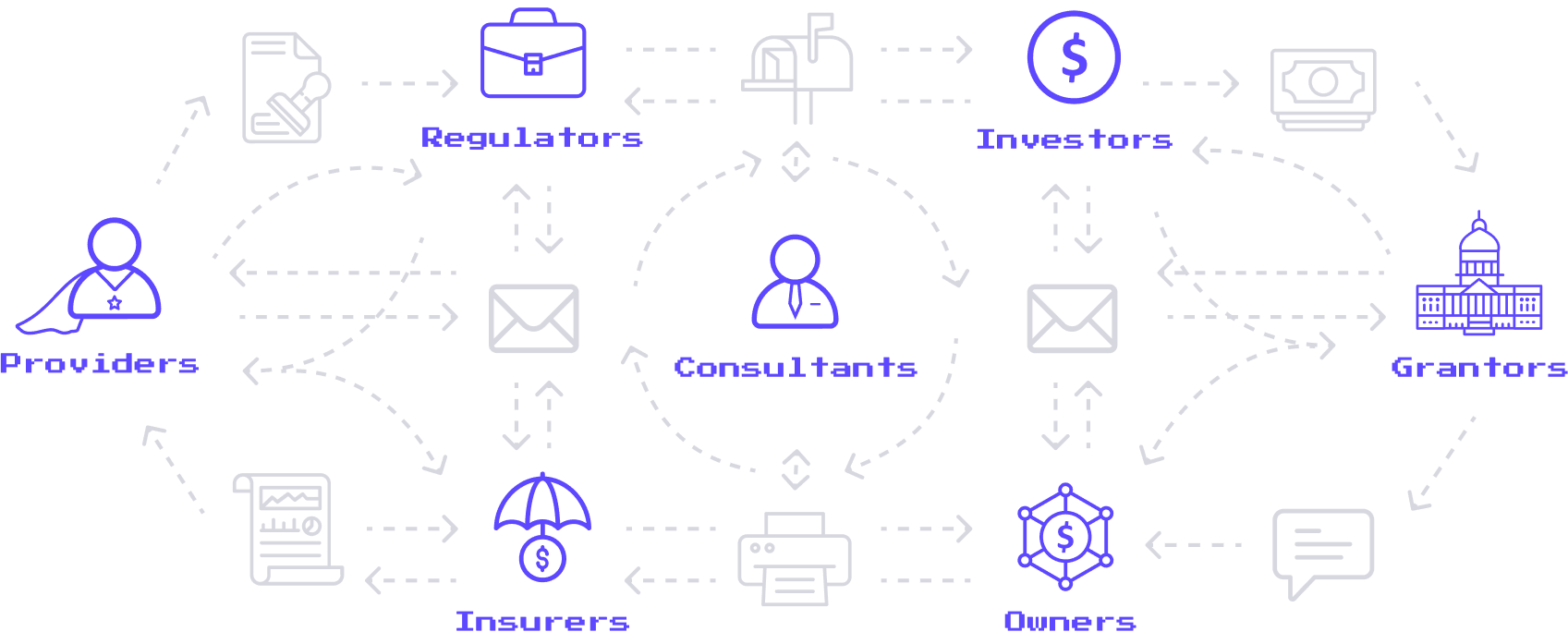
Agents for Agencies
October 10, 2024
·
8 min read
Reliable, affordable utilities form the bedrock of digital economies.
Government agencies and offices who fund and regulate utilities play vital roles in modern life, working behind the scenes to ensure reliable, affordable, ubiquitous access to critical services like broadband, energy and water.
Such agencies and offices can benefit directly from recent advancements in AI, specifically in predictive AI and geospatial AI.
For government agencies tasked with funding and regulating such utilities, AI presents an unprecedented opportunity to enhance operational effectiveness, ensure compliance, optimize focus, and foster sustainable, responsible use of public resources. Correctly deployed predictive AI and geospatial Agents can enable breakthroughs in efficiency, oversight, and innovation, empowering offices like yours to do more with less, through smarter, data-driven decision-making processes and automation of highly repetitive reporting & compliance paperwork.
Agents for your Agency: A Quick Primer
What are AI Agents? AWS defines an AI agent as a software program “that can interact with its environment, collect data, and use the data to perform self-determined tasks to meet predetermined goals. Humans set goals, but an AI agent independently chooses the best actions it needs to perform to achieve those goals.” It is estimated there are already 500 million agents operating in the world, and Facebook founder Mark
Zuckberg predicts agents will outnumber humans in a not-distant future.
Unstop classifies five types of agent, roughly corresponding to evolutionary milestones from simple to complex:
- Simple reflex agents that go to work if some single condition turns out to be true
- Model-based agents go a step further, actively seeking ways in which a condition is true
- Goal-based agents go another step further, figuring out the optimal path to a specific goal
- Utility-based agents seek to accomplish goals through optimal means among alternatives
- Learning agents do everything above, learn from their experiences, incorporating lessons learned into future actions
Multi-agent systems are exactly as they sound: your system involves multiple specialized agents coordinating with one another for even greater operational efficiency.
At the time of this writing, we’re already well into learning agents operating in multi-agent systems. The picture of the Agentic Economy is beginning to come into focus and it appears to hold great potential for helping to bring affordable, accessible utility services for all.

Off the shelf doesn’t work for offices & agencies like yours
At Ready, we look for ways that Agents can help customers do more, with less. In the world of regulated utilities, this nearly always involves a complex mix of factors that aren’t drivers in other sectors:
- Geospatial: there is a physical layer to utility infrastructure, therefore most problems faced have a geospatial nature that does not stop at mapping as a standalone exercise.
- Multi-stakeholder: utility regulators, funders, insurers and operators all play roles in utility service delivery. This looks like an active supply chain.
- Regulatory dimension: regulated utilities like broadband by definition involve regulatory requirements, often beyond regulations encountered in many other sectors.
- Ongoing: there is usually collaboration unfolding across months or years, such as post-award grant reporting & compliance
- Mostly manual: the way these types of recurring tasks unfold today involves lots of back and forth between stakeholders; typically information is lugged across email inboxes and primitive file servers with web uploads, occasionally feeding DIY assemblies cobbled together with visual basic, duct tape & love.

Utility services have many behind-scenes stakeholders working together in highly fragmented ways.
Because of that, offices and agencies who interact with utilities like broadband require specialized Agents adept at predictive and geospatial AI.
Thoughtful preparation is required to get the office ready to benefit from Agents.
Delivering utilities was never easy, but it’s becoming vastly more complicated as the world becomes more complex. The old world of mostly centralized production (think big data centers and giant power plants) serving mostly fixed points of consumption (households) continue to shift toward increasingly decentralized production and variable consumption points.

When complexity increases by orders-of-magnitude and combines with resource constraints, as well as accelerating rates of social, economic & environmental change, governments who work to ensure accessible, affordable utilities for all must find new ways to do more, with less.
Predictive AI and to a lesser extent generative AI hold massive potential for agencies who are ready for Agents. Broadband offices, utility regulators, and providers can now benefit directly from the transformation underway.
Preparing your office to benefit from Agents starts with digitizing your relationships, then routinizing your stakeholder interactions.
- Digitize your stakeholder collaborations Your stakeholders should all interact with your office digitally for all official processes. Whether you’re accepting challenges, auto-scoring grant applications, or automating post-award reporting & compliance, your stakeholders should have an account registered with your office.
- Automate your reporting & compliance, and other routine workflows
- For agencies and offices working closely with utility providers such as ISPs, the easiest way to get ready for Agents starts with Automating reporting & compliance.
- Once you’ve digitized and routinized your essential data flows, you are now ready to layer in Agents to help you do more, with less.
- Train & deploy your Agents
- Setting your Agents up for success
- Once you’ve gotten past manual processes, inbox-driven workflows, Train agents to perform tasks Your agents can assist you in a broad range of recurring tasks.
- Build in quality control & feedback loops
- Your Agents should get better and better over time, as they can learn and have access to a mission-critical input: your attention and feedback.
- Invest in quality assurance and help your Agents get better through direct feedback.
You’ve probably seen the fantastical imagery being produced by generative AI.
How might predictive, geospatial, and generative AI agents benefit your agency? Out of hundreds of clear examples already happening in other sectors, here are six major benefits predictive and geospatial Agents can bring to utility-focused agencies and offices like yours:
1. Regulatory Compliance and Oversight: Automated Reporting & Compliance (ARC)
Your office / agency is tasked with ensuring regulated utilities deliver as-expected, including broadband offices deploying BEAD to providers who must meet the exacting requirements of NTIA as well as your office’s supplemental requirements. Agents can help you.
- Real-Time Monitoring: Agents can monitor project progress against regulatory compliance in real-time, flagging any deviations from project plans or regulatory requirements, which helps in maintaining project integrity and compliance.
- Fraud Detection: Using machine learning algorithms, Agents can detect unusual patterns in financial transactions or project reports that might indicate fraud or mismanagement, enhancing oversight.
- Anomaly Detection to Combat Waste, Fraud, and Abuse (WFA): Agents can analyze patterns in spending, project timelines, and performance metrics against historical data or expected benchmarks. For instance, if an ISP's spending on materials suddenly spikes without a corresponding increase in network coverage or if project timelines consistently lag without justifiable reasons, Agents can flag these anomalies for further investigation. This helps in early detection of potential fraud or mismanagement.
- Real-time Monitoring: ARC can integrate directly with your subgrantee’s systems to monitor network performance metrics in real-time. AI algorithms can then predict when and where network failures might occur or identify areas where service quality dips, suggesting either inefficiency or intentional underperformance.
- Automated Compliance Checks: Agents can automatically check if the project milestones, financial transactions, or service quality metrics comply with the terms of the grant. This reduces the burden on human auditors and ensures that non-compliance issues are caught early.
- Automated Audit Trails: Why wait until the field audit to gather performance records? Agents can help your office maintain detailed logs of all transactions and decisions made with funding you supplied, as well as from deployed equipment you funded. Having a near-real-time view of your sub grantee’s progress is an important capability to ensure full resource utilization.
- Risk-Based Auditing: Agents can help you prioritize audits based on risk, using machine learning to determine which entities or transactions are most likely to have issues, thus optimizing audit schedules.
- Dynamic Reporting: Instead of static reports, Agents can generate dynamic, predictive reports that not only detail past performance but also forecast future outcomes based on current trends. This helps in proactive management rather than reactive.

2. Predictive Analytics for Funding Allocation: Full Lifecycle
Your office / agency deploys resources into utility providers with an expected level of increased connectivity or service quality. Well-trained geospatial AI agents for government can help you reach new levels of effectiveness.
- Demand Forecasting: Agents can analyze demographic trends, economic data, and usage patterns to predict where broadband demand will increase, helping governments allocate funds more efficiently to areas most in need.
- Risk Assessment: By evaluating historical project data, Agents can predict which projects might face delays or cost overruns, allowing for better risk management and funding adjustments.
3. Optimizing Resource Allocation
- Predictive Maintenance and Planning: By analyzing data from network operations, Agents can predict maintenance needs, optimize the deployment of resources, and even suggest the best times for upgrades or expansions based on usage patterns, weather forecasts, or demographic shifts.
- Cost Efficiency: Agents can analyze the cost-effectiveness of different project phases or materials used, suggesting alternatives or adjustments in real-time to save costs without compromising quality.
4. Transparency and Accountability
- Audit Trail and Decision Support: Every decision or anomaly flagged by Agents can be logged, creating a transparent audit trail. This not only aids in combating WFA but also in defending against allegations of mismanagement.
- Public Trust: By showcasing how AI ensures funds are used efficiently, governments can enhance public trust in how infrastructure projects are managed, especially critical in projects like broadband where public investment is significant.
5. Scalability and Integration
- Scalable Oversight: As more projects come online, AI scales effortlessly, handling increased data loads and complexity without proportional increases in human oversight costs.
- Integration with Other Systems: ARC could integrate with other government systems for holistic oversight, combining data from financial transactions, project management tools, and even public feedback to create a comprehensive view of project health.
6. Learning and Adaptation
- Continuous Learning: AI models can learn from each project cycle, improving predictions and anomaly detection over time. This means your Agents get more effective at spotting sub-optimal resourcing or waste, fraud & abuse as time goes on.
- Feedback Loops: Incorporating feedback from your team refines decision-making criteria, making your Agents more aligned with your expert judgment and evolving regulatory nuances.
Utility Funders & Regulators Is your office or agency Ready for AI? Connect with us for a free consultation and demo of Ready BOSS: your Back Office Secret Sauce.
The government offices and agencies who are ready, able, and willing to harness Agents are the ones who will make the highest and best use of public resources aimed at accessible, reliable broadband, energy and water utility services. Such orgs will make outsized impacts on the lives of their constituents, incurring fewer headaches and lower costs in the process. Are you ready?
Thank you to @sockcymbal, Ready AI team and @grok for contributing to this thought piece.

